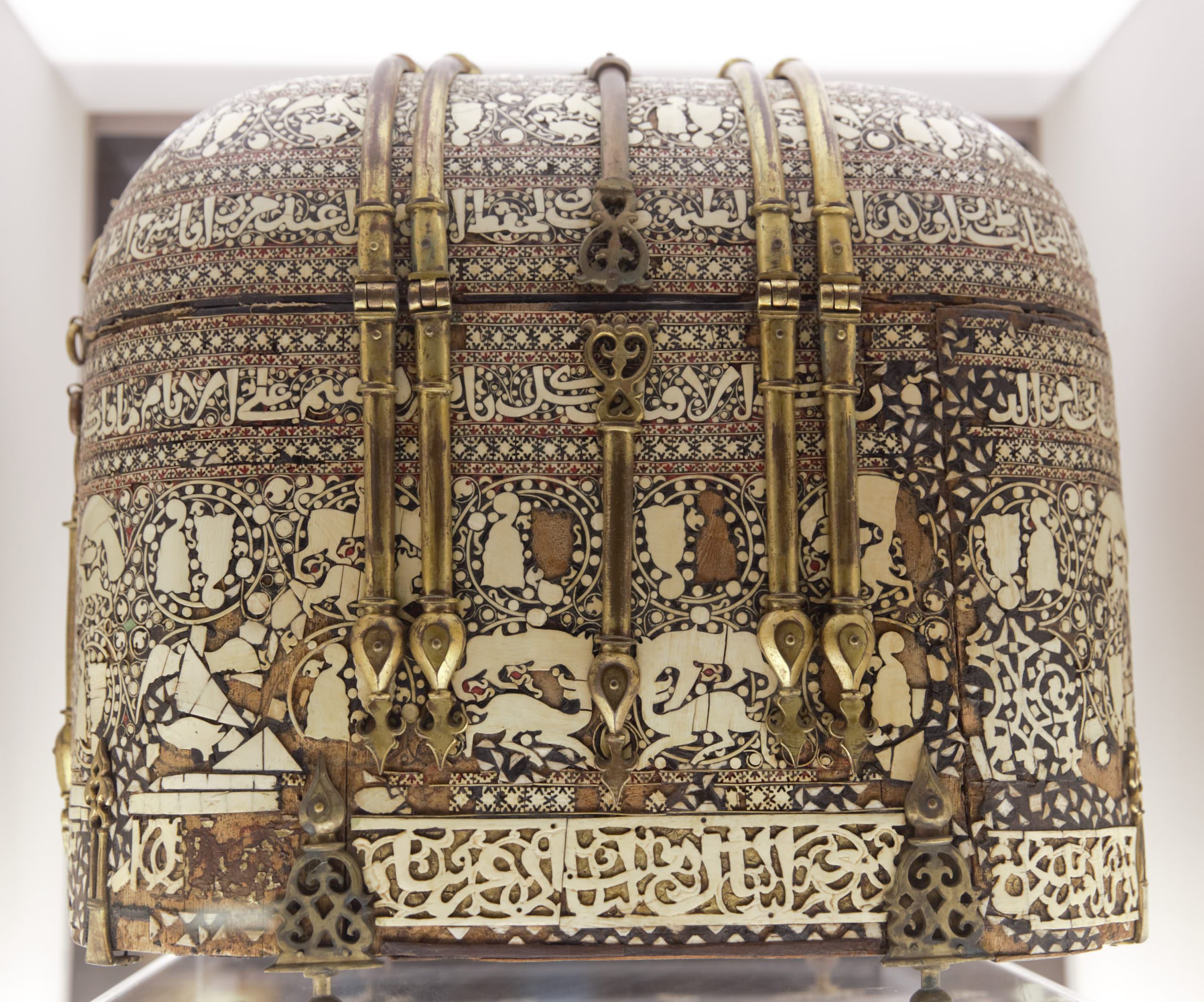35
Cross-cultural perspectives
Dr. Ariel Fein
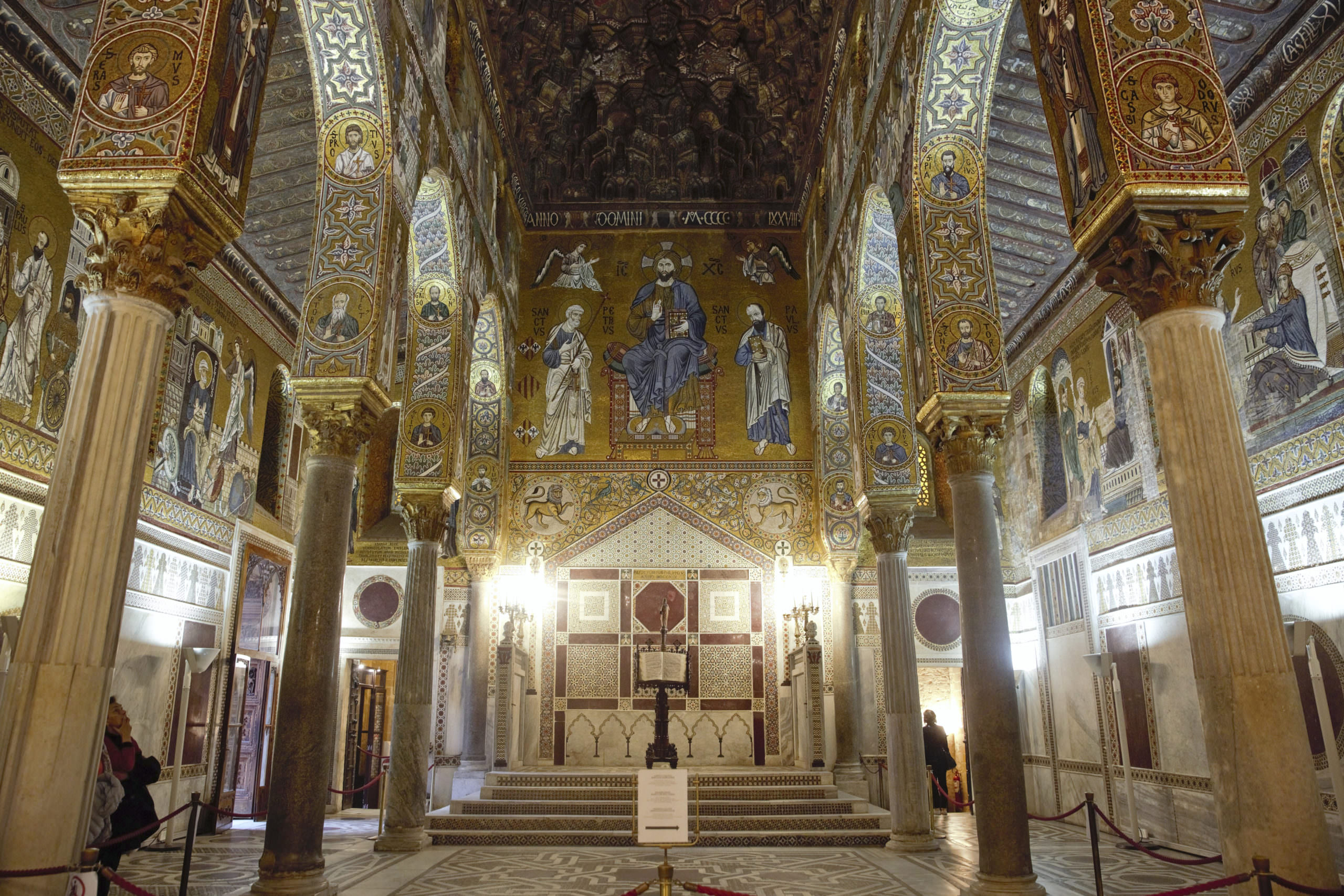
On the southern Italian island of Sicily, a richly decorated church known as the Cappella Palatina presents a puzzling pastiche of art and architecture that feels at once Byzantine, Islamic, and Roman- esque. The Cappella Palatina was built by Normans of French descent in the twelfth century. But what can explain its eclectic decoration?In 1130, the Norman Count Roger II consolidated the territories of Southern Italy and Sicily and established himself as ruler over the new Kingdom of Norman Sicily, which endured from 1130 to 1194. As a result of centuries of both Byzantine and Islamic rule, the island was already home to a religiously and linguistically heterogeneous population of Greek- and Arab-Christians, Muslims, and Jews. (Greek- and Arab-Christian communities worshipped according to the Orthodox Christian tradition of the Byzantine world. While the language of the liturgy was Greek, Arab-Christians may have also worshipped in Arabic, as well as spoke Arabic in their day-to-day interactions.) Although they were Latin Christians loyal to the Pope in Rome, King Roger II and his successors William I (reigned 1154–66) and William II (reigned 1166–89) cultivated a royal policy that engaged the island’s religious and cultural diversity—they retained Islamic and Greek administrative and fiscal structures alongside new Latin Christian institutions, commissioned royal inscriptions in Latin, Greek, and Arabic, and patronized learned Arabo-Muslim (those identifying with the Arab world and the Islamic faith) and Greek scholars, poets, and artisans passing through their court. Through these deliberate borrowings, the Norman kings sought to establish themselves as political players on par with their Byzantine, Islamic, and western European counterparts. The commissioning of architecture and works of art that drew upon and imaginatively juxtaposed Byzantine, Islamic, and Romanesque visual sources lay at the heart of this project. Through their patronage, the Norman kings proclaimed the glory of their nascent kingdom and the legitimacy of their role as Christian monarchs. Nowhere was this more the case than in Roger II’s palace chapel, the Cappella Palatina.
The Cappella Palatina in the Royal Palace
In the heart of the Kingdom’s capital city of Palermo, King Roger II built his royal residence, the Palazzo Normanni. Situated at the city’s highest point, and likely on the site of an earlier Islamic fortress, the palace grounds furnished an ideal setting to stage the legitimacy of the new monarchy. Constructed around three towers, and outfitted with audience halls, royal dwellings, royal workshops, the state treasury, and luxurious gardens, the center of the compound was the king’s Cappella Palatina (or palace chapel).

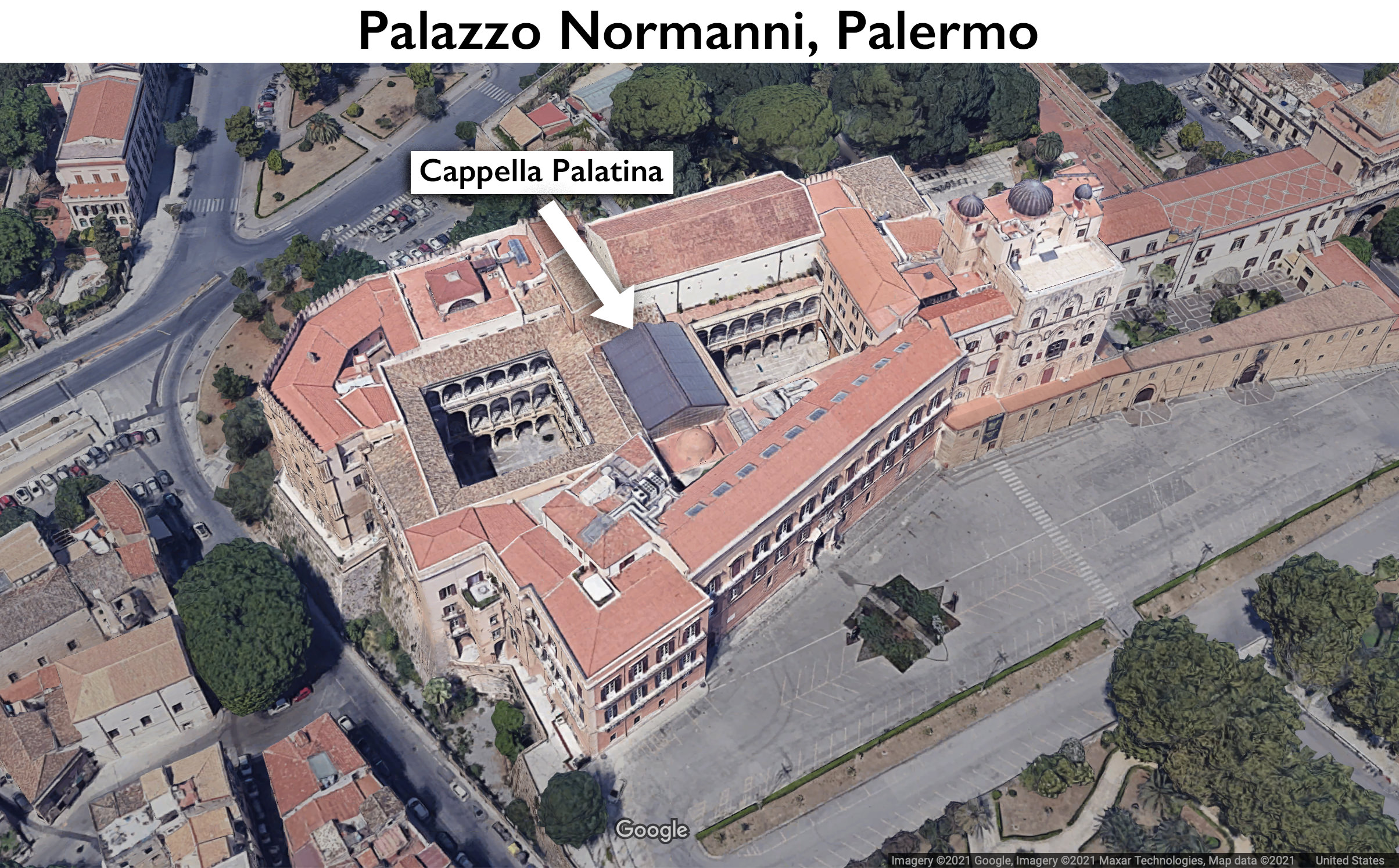
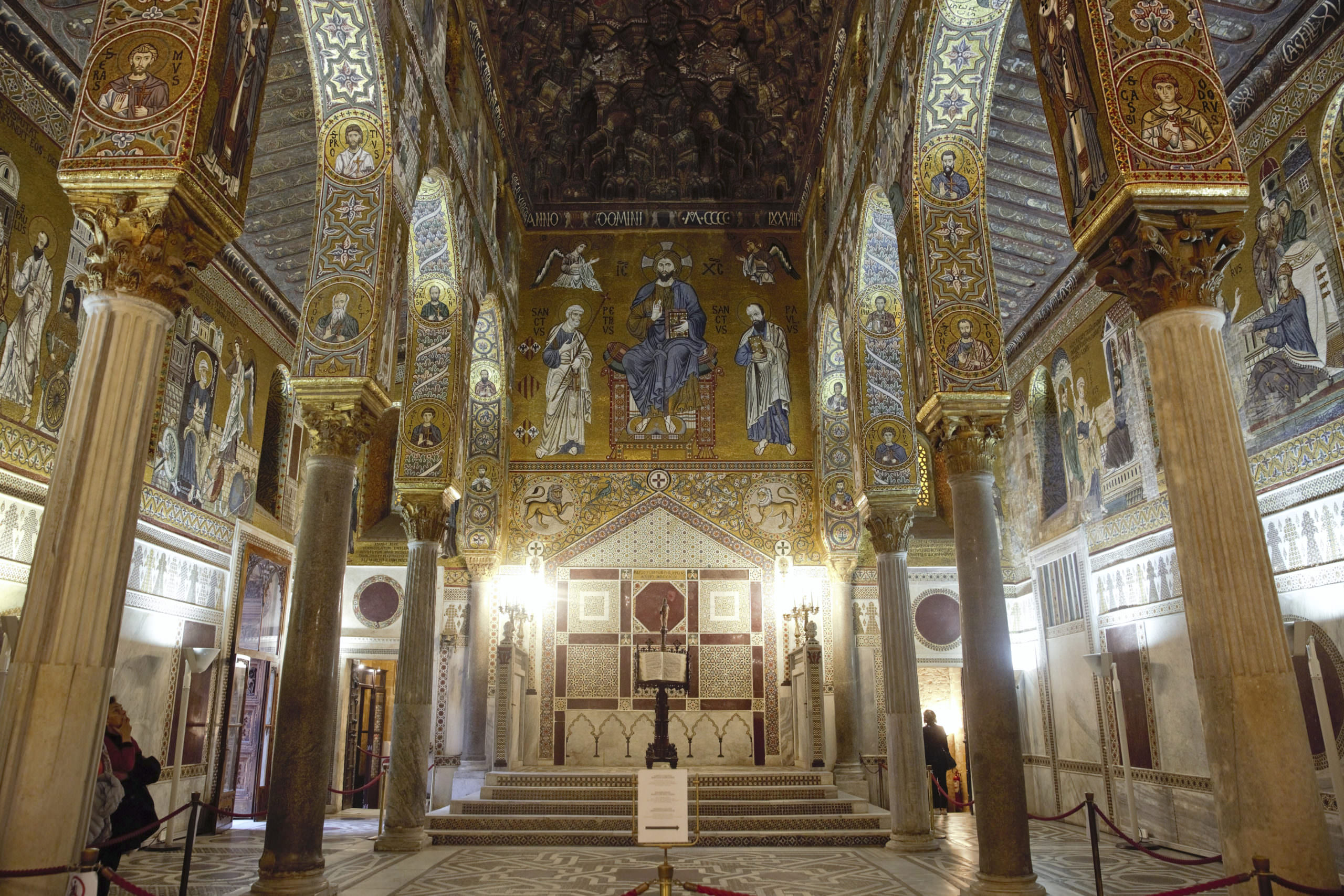
The chapel functioned as both the religious center of the palace, furnishing a space for the performance of church services, as well as the royal audience hall, a venue for royal ceremony. In its eclectic combination of Byzantine, Islamic, and Romanesque architectural and decorative traditions, the Cappella Palatina embodies the multicultural cosmopolitanism of Palermo.
Although small in size, the Cappella Palatina is remarkably full of elaborate decoration, bewildering and disorienting viewers as they try to make sense of the chapel’s varied media and visual styles. Adorning the chapel interior are bedazzling golden mosaics, richly patterned opus sectile floors, marble wall revetments, a painted wooden honeycomb-like muqarnas ceiling, and a carved pulpit (an elevated platform used for reading and preaching during church services) and paschal candelabrum. (The paschal candelabrum holds a large candle burned in church services during the Easter, or Paschal, season.)
Architecturally, the Cappella Palatina consists of two primary parts: a domed, centrally planned sanctuary in the east joined to a three-aisled basilical hall in the west that is surmounted by a wooden muqarnas ceiling. (Muqarnas refers to the complex, honeycomb-like decoration typical of Islamic architecture.) In its east end, Byzantine-inspired mosaics cover the entire upper part of the building. Christ Pantokrator—which means “almighty” or “ruler of the universe”—crowns the summit of the main dome with angels, while Old Testament prophets, apostles, and saints are arranged below.
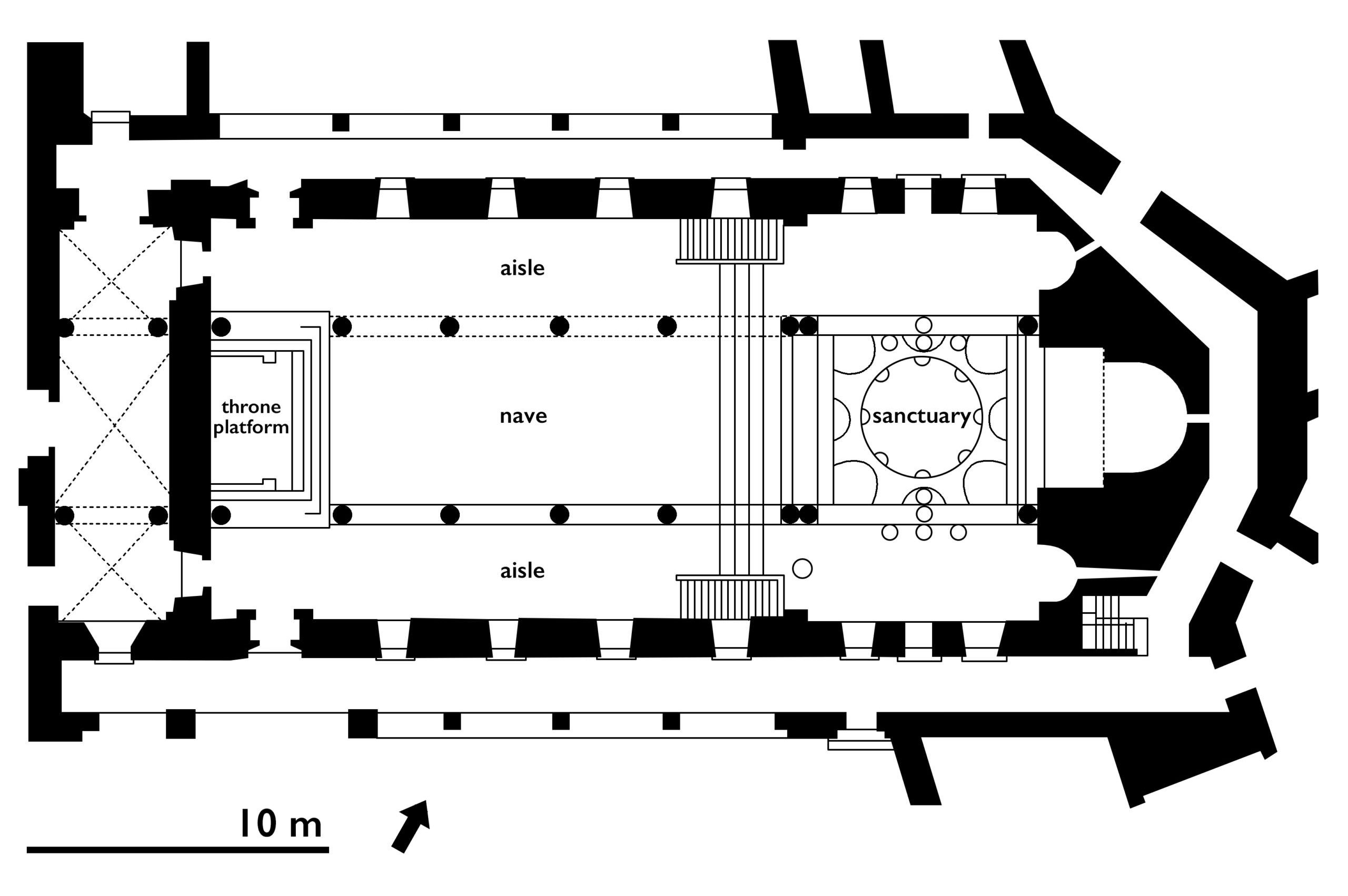
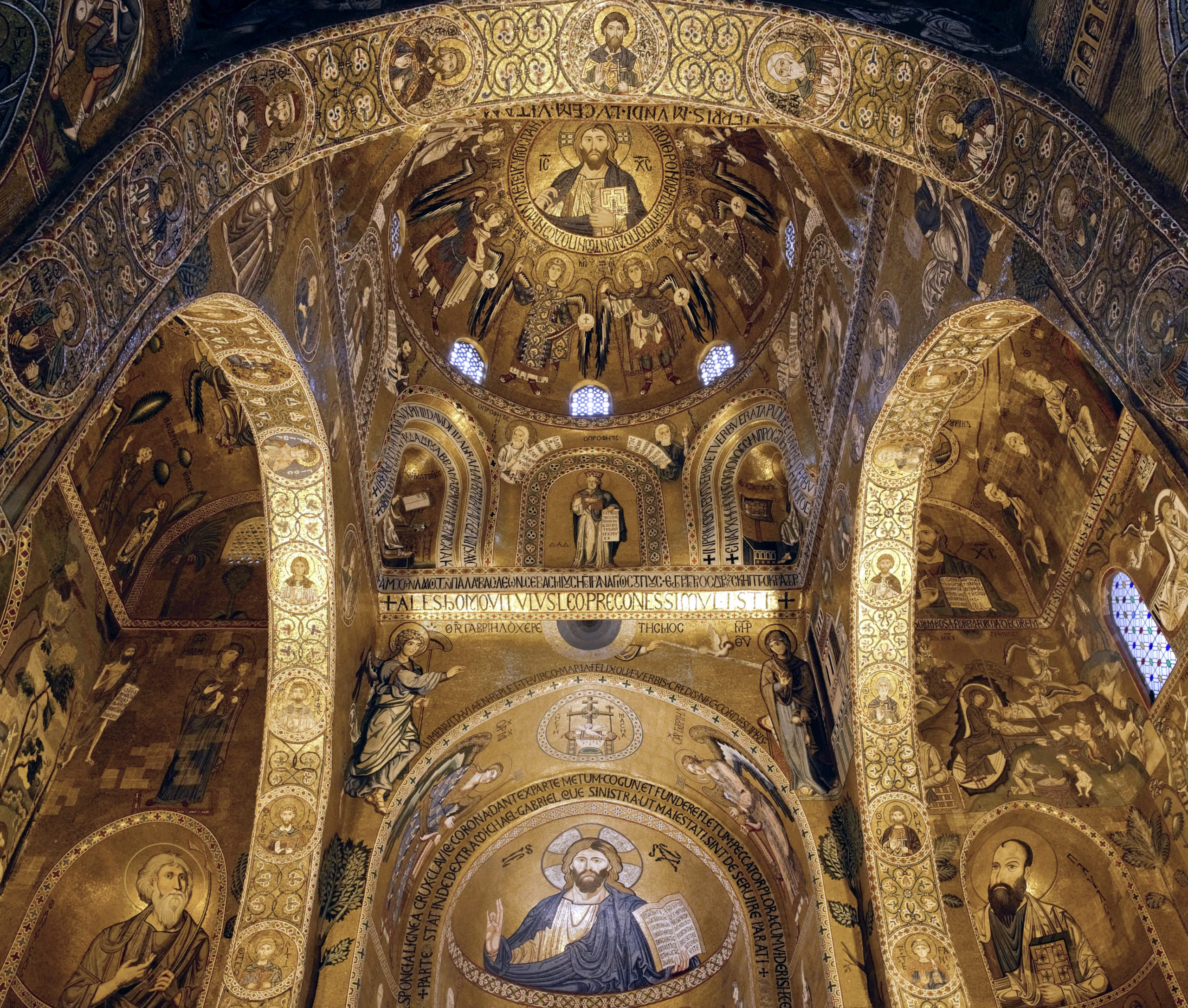
Further scenes from the life of Christ occupy the upper vaults and the lower walls of the sanctuary. A second mosaic cycle with scenes from the Old Testament and the lives of the apostles Peter and Paul, likely completed during the reigns of Kings William I and II, adorns the aisles of the nave.
A grand, painted muqarnas ceiling dominates the nave. Its two parallel rows of coffering in the form of eight-pointed stars are painted in their entirety with images of banquets, musicians and dancers, battles and hunting, mythological subjects, real and fantastical animals, and Islamic-style decorative motifs accompanied by Arabic inscript- ions invoking blessings.
Although drawing heavily upon Byzantine and Islamic visual traditions, the origins of the artisans who built and decorated the chapel remains unclear. A subject of ongoing debate, scholars suggest that the mosaicists may have been local craftsmen, rather than imported from Byzantium, and the workers designing the muqarnas ceiling may have originated from Sicily itself, Fatimid Egypt, North Africa, northern Syria, and/or northern Iraq.
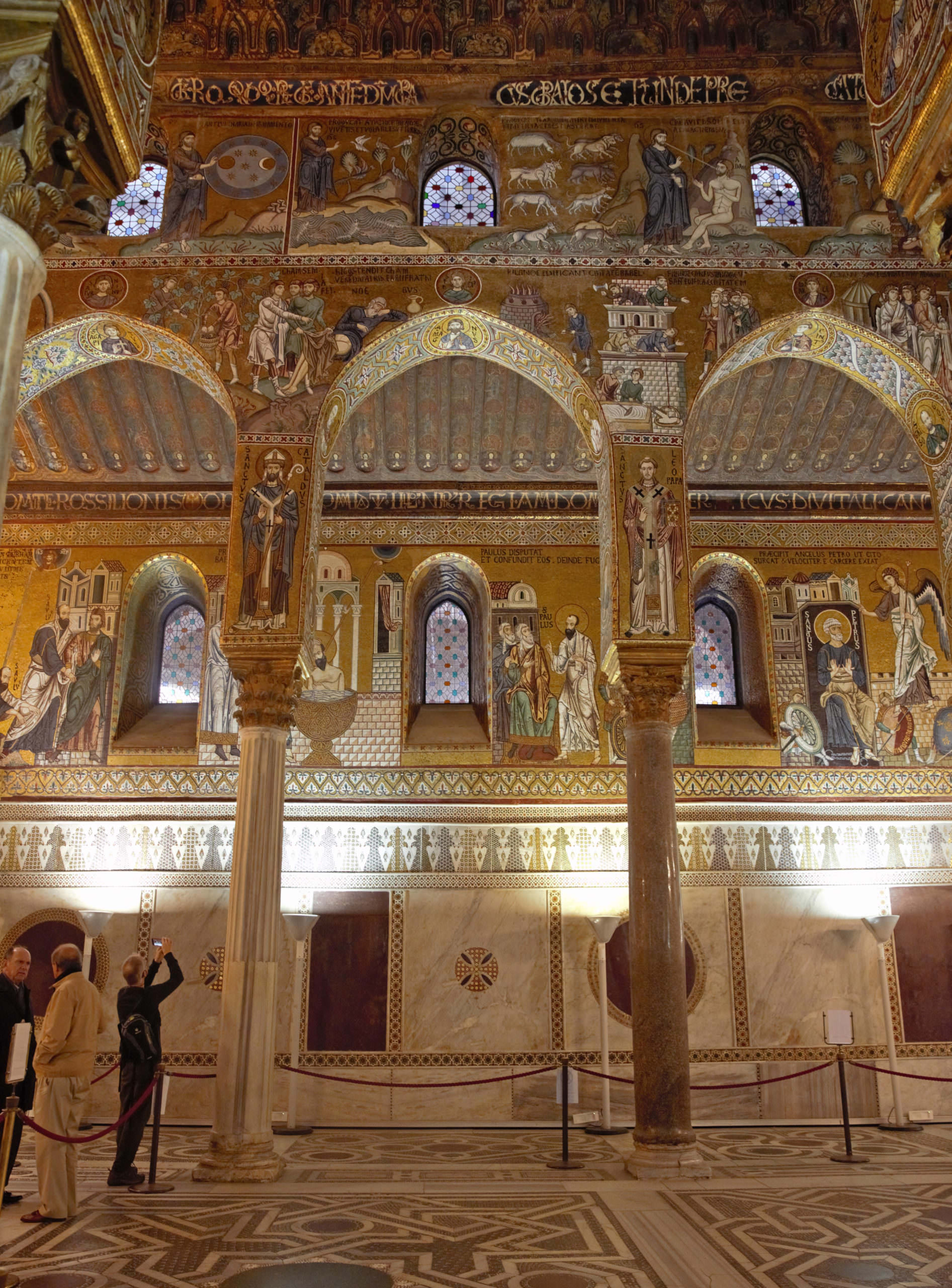

*
With such a complex and diverse visual program, it is tempting to divide the Cappella Palatina into its constituent elements—Byzantine, Islamic, and Romanesque. From this perspective, the basilica nave can be seen as Norman or Roman, the domed sanctuary with its rich mosaic decoration reflects Byzantine influence, and the wooden muqarnas ceiling suggests an Islamic contribution (a similar muqarnas ceiling can be seen in the Almoravid al-Qarawiyyin Mosque in Fez). But for the medieval viewer, these categories were blurred at best. Moreover, visitors encountered and experienced the monument as a whole ensemble, rather than as fragmented parts. How did they understand the Cappella Palatina’s diverse range of visual vocabularies, and why did the Norman king employ such an eclectic visual language in the first place?
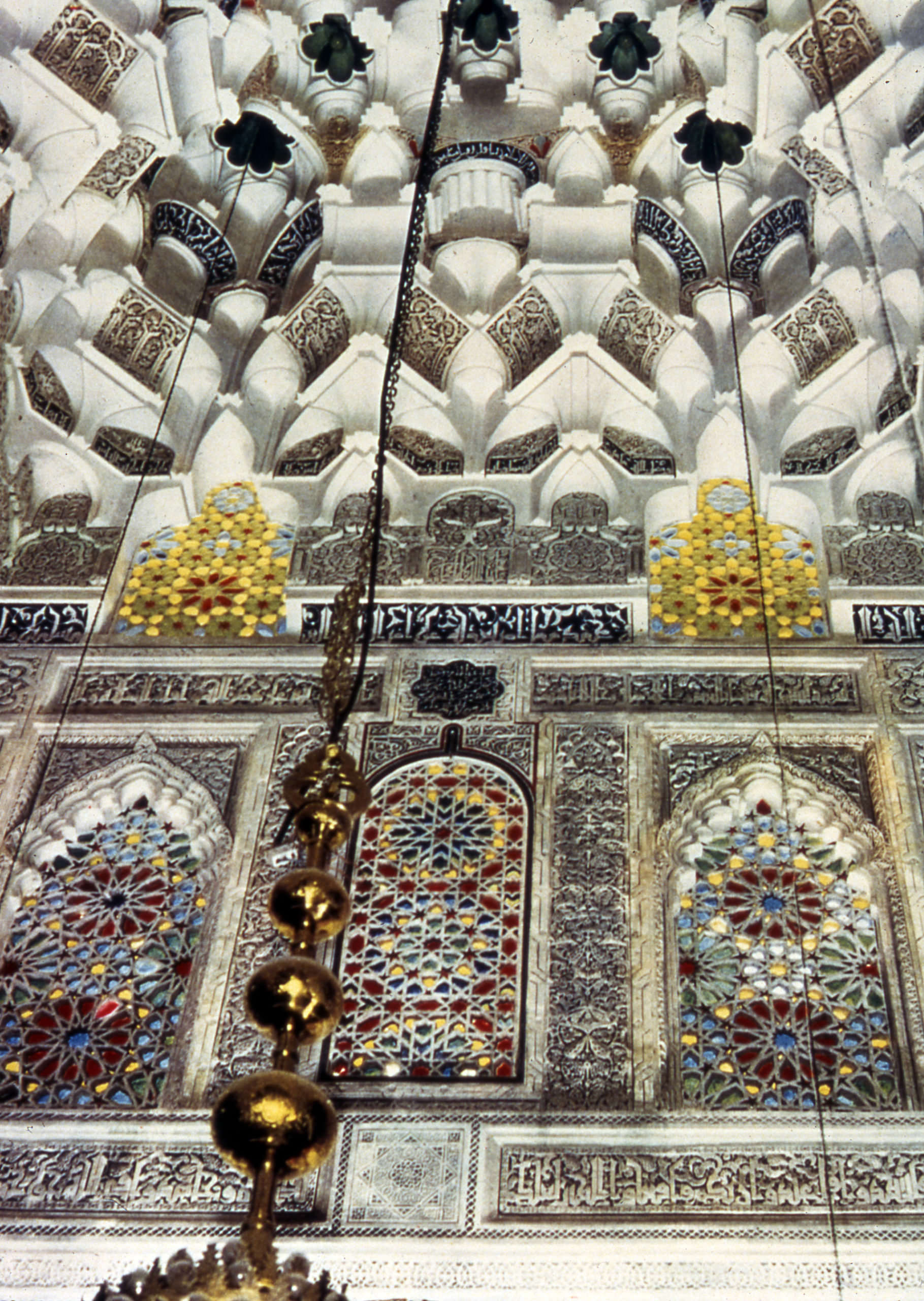
Royal Propaganda in the Cappella Palatina
Although the Cappella Palatina’s architecture and decoration featured styles and crafts culled from across the Mediterranean basin—from Sicily and Southern Italy itself, Byzantium, Fatimid Egypt, the Maghreb (Northwest Africa, including modern-day Algeria, Libya, Morocco, Tunisia, Portugal, and Spain), and the Crusader Levant (the region occupied by crusaders on the eastern Mediterranean shores, including modern-day Egypt, Israel, Jordan, Lebanon, Syria, and Iraq)—when seen together, they present a unified royal program. The king’s eclectic appropriation of Byzantine and Islamic royal iconographic motifs served as an integral component in projecting his imperial ambitions to both his subjects as well as neighboring monarchs.
Although covered today with modern mosaics, a royal viewing box was originally positioned in the upper north wall of the sanctuary. From this privileged point, the Norman king was not only elevated above his subjects, but also afforded a unique view of the mosaics adorning the opposite wall. From the royal balcony, the king was positioned directly across from the scene of the Transfiguration, recounting when Christ revealed his divinity to the apostles, Peter, James, and John. The king was thus integrated among the apostles as a direct witness to the glorification of Christ. But to the worshippers standing below, the Christ of the Transfiguration and the king (framed within the royal box) appeared on the same level, associating the divine king—Christ—with the divinely appointed Norman king.

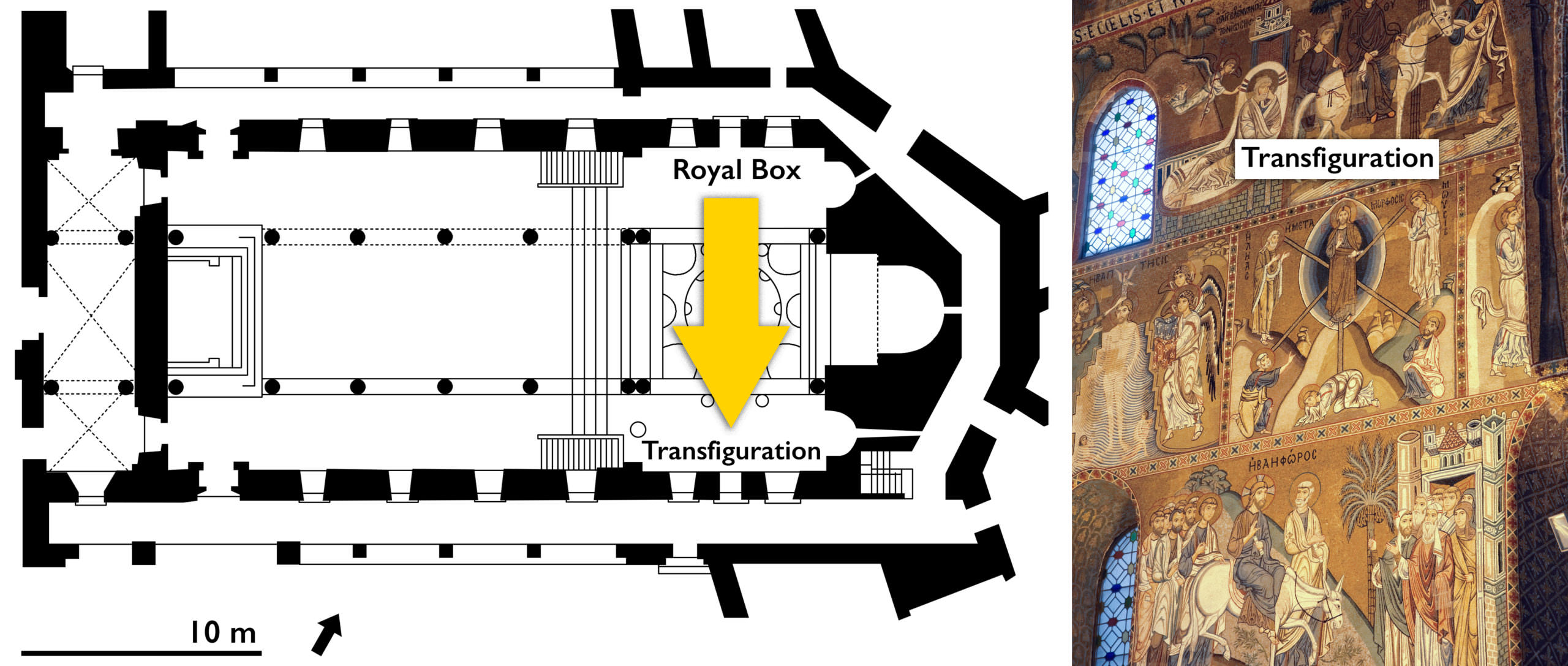
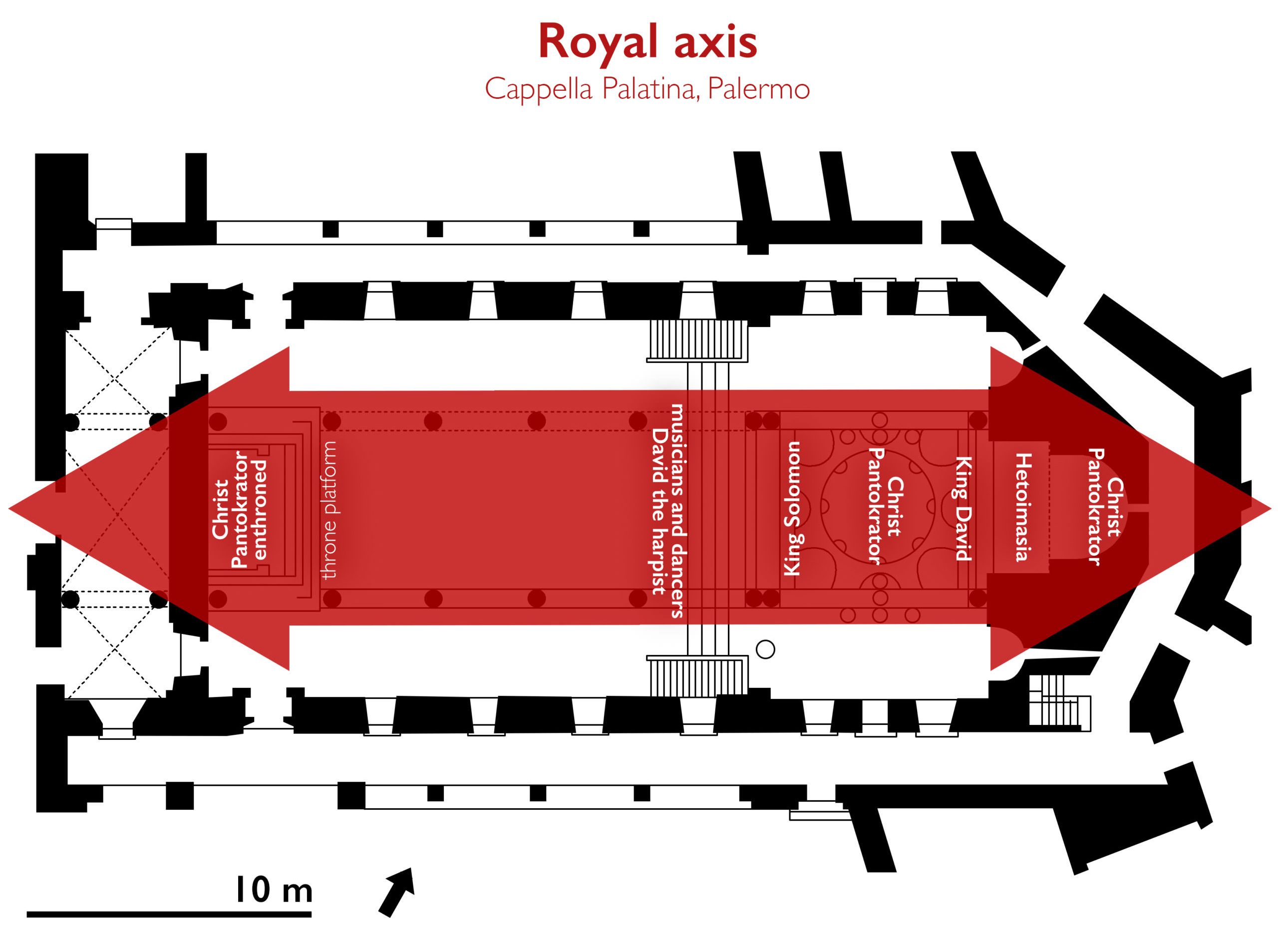
A royal axis runs across the entire length of the chapel nave and sanctuary, linking the Norman king to images of Christ and biblical monarchs. A monumental image of the enthroned Christ adorns the western wall just above the Norman king’s throne-platform.
Along this same longitudinal axis are two mosaic icons of the kings David and Solomon, both biblical paragons of monarchic virtue. They, along with a painted image of a seated harpist (likely King David) in the muqarnas ceiling, elevate the status of the chapel by associating its patron with significant biblical rulers.
The royal axis continues through the Hetoimasia, the empty throne of Christ prepared with the instruments of his passion to culminate in the Christ Pantokrator in the central apse.
(The Hetoimasia, or “prepared throne,” is a symbolic image that combines such elements as a throne, the Holy Spirit as a dove, a Gospel book, a cross, and instruments of the Passion.)
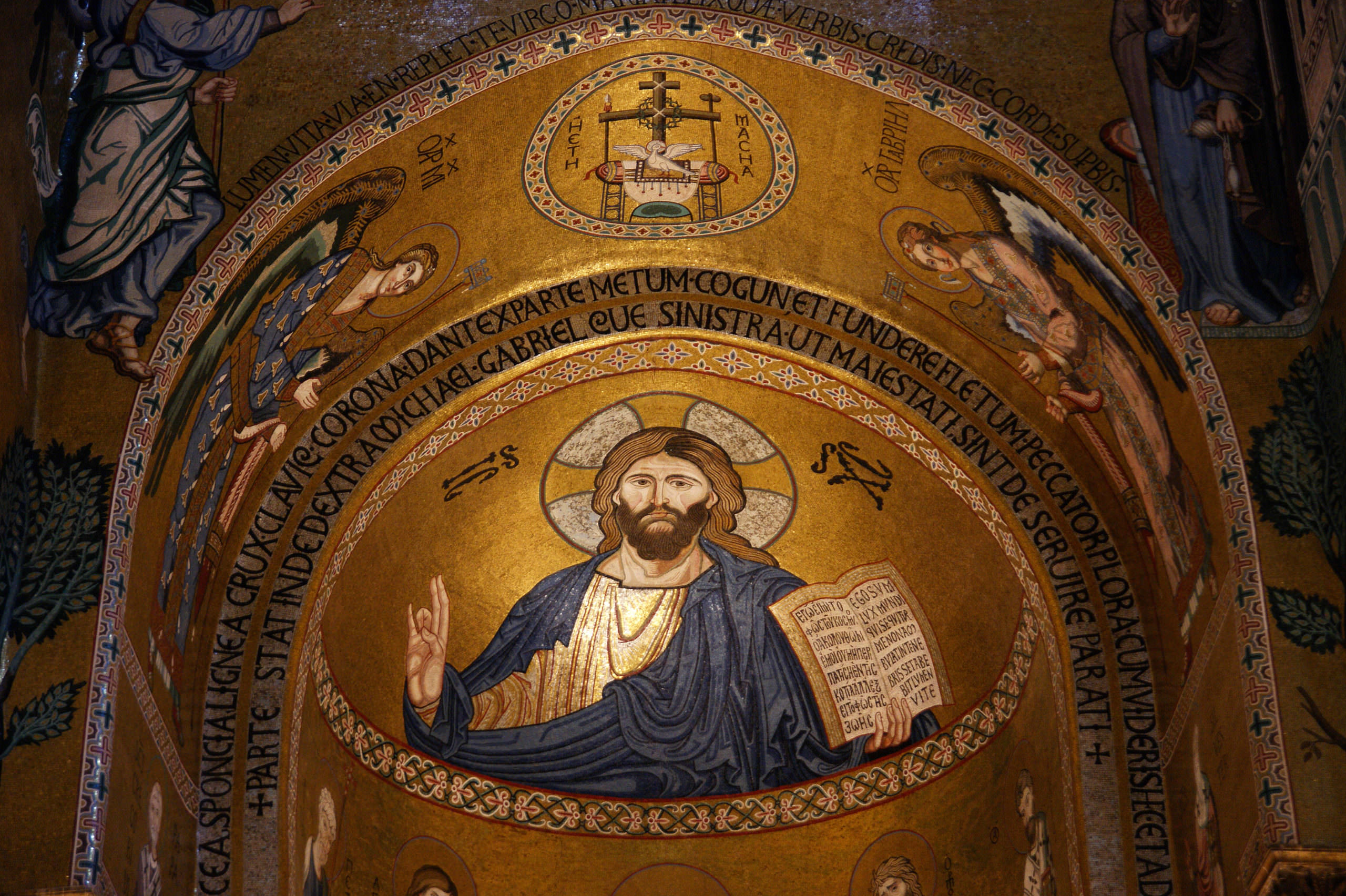
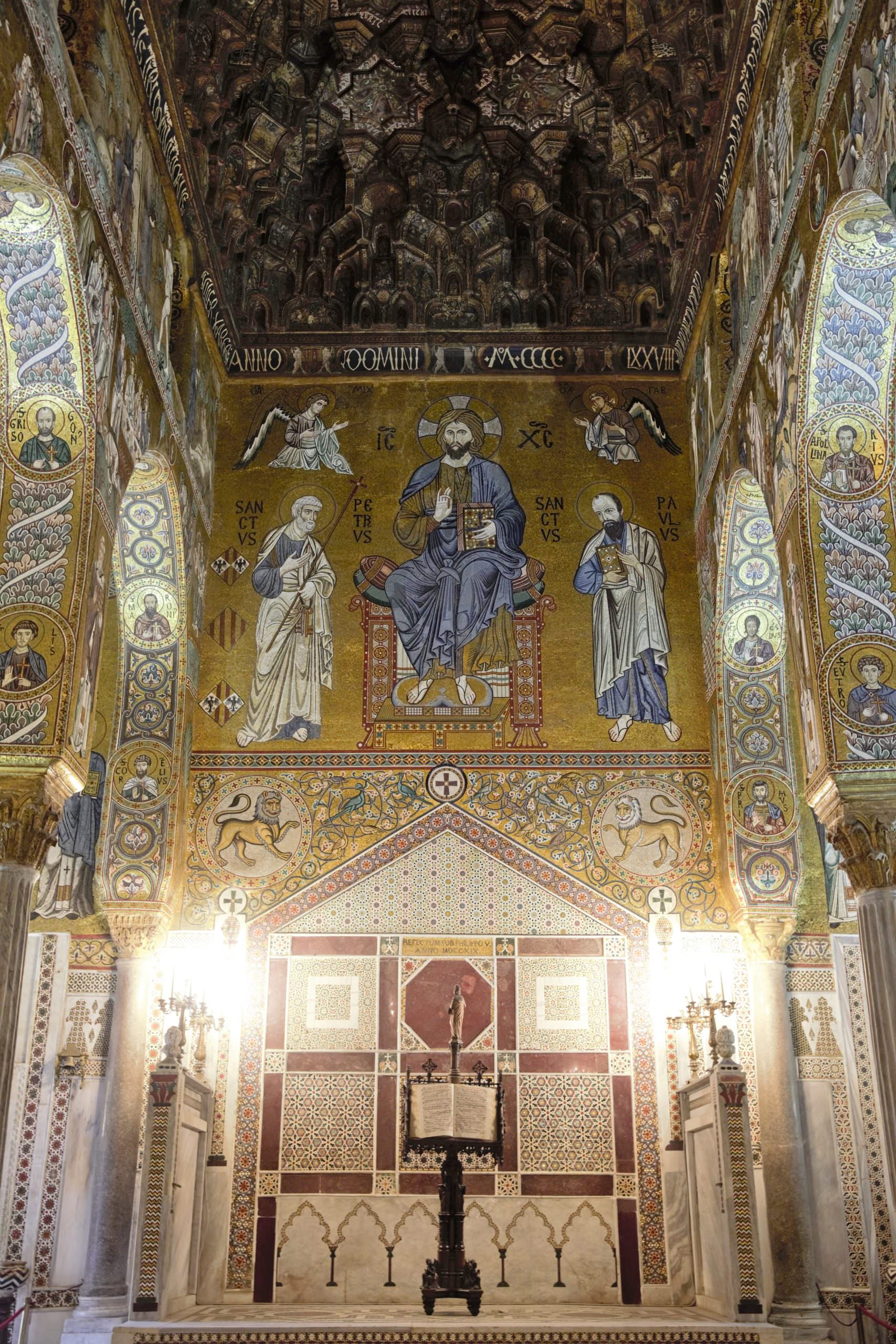
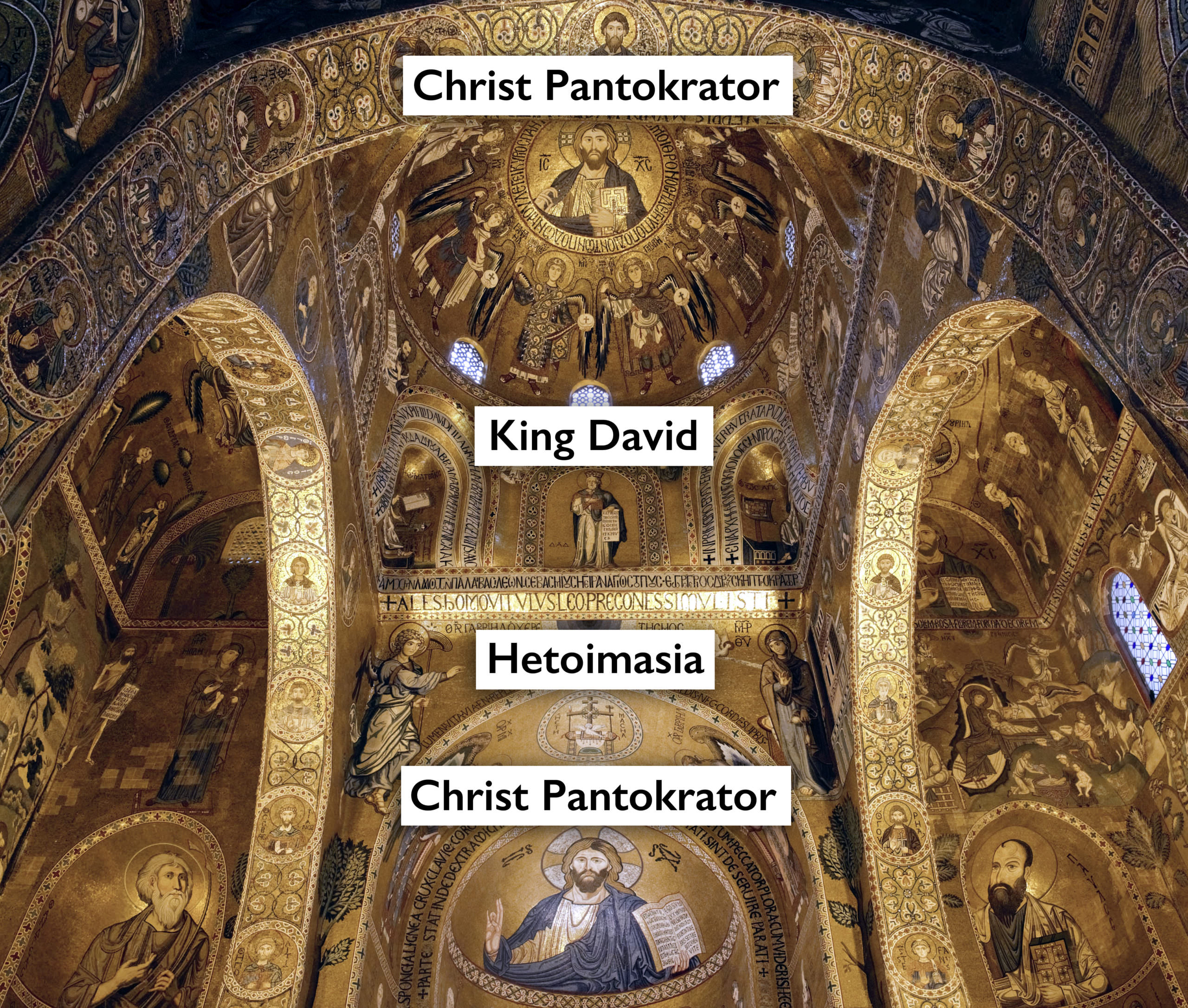
Alongside these mosaic images, a painted cadre of courtly revelers, concentrated in the muqarnas ceiling’s eastern end, celebrate with music, dance, and drinking vessels. They appear to stage a princely banquet honoring the patrons of the royal chapel—the Sicilian monarch and the Christian God. The sheer number of royal references along this axis make explicit the royal program, enhancing the ruler’s authority among his subjects and conveying his divine inspiration.

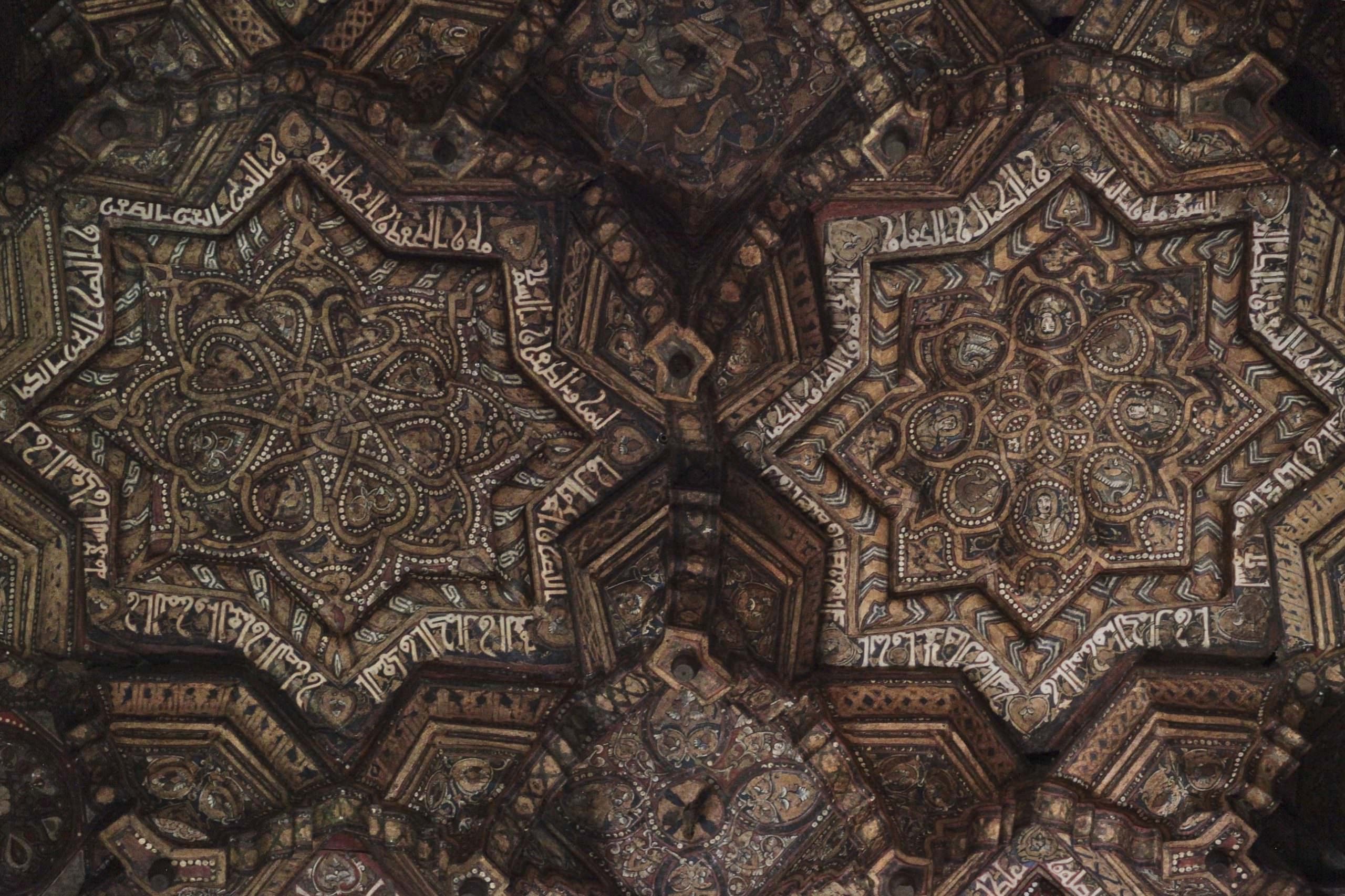
Finally, painted Arabic supplicatory phrases bordering the star-shaped coffers and framing the niche-like units of the nave’s muqarnas ceiling also augment the chapel’s royal imagery. The ceiling’s painted texts include such phrases as: “attainment and victory, power, perfection and good-fortune, and security and bliss and power. . .” —all qualities associated with royalty. Although medieval Palermo hosted a sizable community of Arabic speakers and readers, the texts’ small size and positioning deep within the ceiling’s coffers would have rendered them extremely difficult, if not impossible, to read from the pavement below.
Although their content likely remained illegible, the presence of Arabic script would have been recognizable and reinforced by other Arabic inscriptions within the chapel, including the opus sectile Arabic epigraphs (inscriptions) framing the chapel’s doors and in other furnishings of the church, such as ivory caskets, textiles, and liturgical vestments (special clothing worn by the clergy during church services) and vessels like this one. This extensive use of Arabic in royal media proclaimed the Norman king’s mastery of the Arabic language and made clear his legitimate position as ruler over a region formerly under Islamic rule.
With its imagery produced by highly-skilled artisans drawn from across the Mediterranean, the Cappella Palatina merged a Christian liturgical space with a royal ceremonial hall to sanction the Norman king’s imperial aspirations as the rightful ruler over a multi-ethnic realm.
Additional Resources
Jeremy Johns, “Arabic Inscriptions in the Cappella Palatina: Performativity, Audience, Legibility and Illegibility,” in Viewing Inscriptions in the Late Antique and Medieval Mediterranean, ed. Antony Eastmond (Cambridge University Press, 2015), 124–147.
Lev Kapitaikin, “David’s dancers in Palermo: Islamic dance imagery and its Christian recontextualization in the ceilings of the Cappella Palatina,” Early Music Journal 47.1 (2019): 3–23.
Lisa Reilly, The Invention of Norman Visual Culture: Art, Politics, and Dynastic Ambition (Cambridge University Press, 2020)
William Tronzo, The Cultures of his Kingdom: Roger II and the Cappella Palatina in Palermo (Princeton University Press, 1997)
